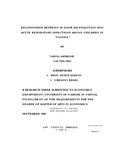| dc.contributor.author | Sansa, Ambrose | |
| dc.date.accessioned | 2013-05-04T07:07:53Z | |
| dc.date.available | 2013-05-04T07:07:53Z | |
| dc.date.issued | 2004 | |
| dc.identifier.citation | A research paper submitted to economics department, university of nairobi in partial fulfillment of the requirements for the degree of master of arts in economics. | en |
| dc.identifier.uri | http://erepository.uonbi.ac.ke:8080/xmlui/handle/123456789/18869 | |
| dc.description.abstract | Evidence from the UDHS 2000/01 data suggests that the prevalence of acute respiratory infection among children below the age of 5 year is 18.33 per cent. Children between the ages 6-35 months were more likely to suffer from ARI compared to their counterparts below
5 months and above 35 months. The highest percentage of children who suffered from ARI were from the Northern region followed by Eastern region. Central and western regions had the lowest ARI prevalence. The logistic results showed that exposure to cooking smoke from biomass combustion increases the odds of contracting ART. Relationship between ARI and other fuels such as LPG and electricity was found to be not significant.
The logit results showed that living standards of households were significantly related to the
ARI case. The highest percentage of children, who suffered from ARI within 2 weeks prior to the survey, lived in households with low living standards. Children from medium and high-Income household had much lower probability of suffering from ARI compared to those from low-income households.
The most vulnerable group is the rural poor who predominantly use biomass for long hours in poorly ventilated shelter. Even with biomass, using improved stoves could minimize exposure to carbon monoxide and improve efficiency. Efficient stoves use less biomass to obtain the required amount of energy and reduce the quantities of particulate matter emitted. Government policies should be designed towards increasing income of the rural poor and basic health care education should be available to rural communities regularly to sensitize
households of the potential dangers of indoor air pollution. | en |
| dc.language.iso | en | en |
| dc.title | Relationship between in door air pollution and acute respiratory infections among children in Uganda | en |
| dc.type | Thesis | en |
| local.publisher | Department of Arts-Economics | en |

